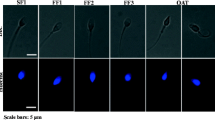Abstract
Purpose: We carried out this study to evaluate the biological significance of phospholipase C β1 gene mutation in mouse sperm in the acrosome reaction, fertilization, and embryo development.
Methods: Study subjects were divided into two groups according to the sperm [intact phospholipase C (PLC) β1 and PLC β1−/− C57BL/6J × CBA F1 mouse sperm] used. The positive acrosome reaction rate labeled with fluorescein isothiocyanate–Pisum sativum agglutinin, the fertilization rate, and the rate of embryos developed to the stage of morula or blastocyst in the two groups were compared.
Results: The mouse sperm null for the PLC β1 gene showed a lower acrosome reaction rate than control sperm (69.2 vs 50.9%, P < 0.05). And the fertilization rate and the rate of embryos developed to the stage of morula or blastocyst were also lower in the group using PLC β1−/− mouse sperm compared to the intact group (P < 0.05; 73.5 vs 51.8% and 15.7 vs 4.3%, respectively).
Conclusions: Mutation of the PLC β1 gene in the mouse sperm reduces the acrosome reaction rate, fertilization rate, and embryo development rate, which may be the etiologic factors responsible for the low reproductive rate of PLC β1−/− mouse.
Similar content being viewed by others
REFERENCES
Breitbart H, Spungin B: The biochemistry of the acrosome reaction. Mol Hum Reprod 1997;3:195-202
Yanagimachi R, Usui N: Calcium dependence of the acrosome reaction and activation of guinea pig spermatozoa. Exp Cell Res 1974;89:161-174
Fraser LR: Motility patterns in mouse spermatozoa before and after capacitation. J Exp Zool 1977;202:439-444
Kopf GS, Gerton GL: The mammalian sperm acrosome and the acrosome reaction. In Elements of Mammalian Fertilization, PM Wasserman (eds). Boca Raton, FL, CRC Press, 1991, pp 153-203
Spungin B, Margalit I, Breitbart H: Sperm exocytosis reconstructed in a cell-free system. J Cell Sci 1995;108 (Pt8):2525-2535
Dupont G, McGuinness OM, Johson MH, Berridge MJ, Borgese F: Phospholipase C in mouse oocytes: Characterization of ? and ? isoforms and their possible involvement in sperm-induced Ca2+ spiking. Biochemistry 1996;316(2):583-591
Walensky LD, Snyder SH: Inositol 1,4,5-trisphosphate receptors selectively localized to the acrosome of mammalian sperm. J Cell Biol 1995;130:857-869
Miyazaki S, Yuzaki M, Nakada K, et al.: Block of Ca2C oscillation by antibody to the inositol 1,4,5-trisphosphate receptor in fertilized hamster eggs. Science (Wash. DC) 1992;257:251-255
Shilling FM, Carroll DJ, Muslin AJ, Escobedo JM, Williams LT, Jaffe LA: Evidence for tyrosine kinase and G proteincoupled pathways leading to starfish egg activation. Dev Biol 1994;162:590-599
Kim DS, Jun KS, Lee SB, et al.: Phospholipase C isozymes selectively coupled to specific neurotransmitter receptors. Nature 1997;389:290-293
Osman RA, Andris ML, Jones AD, Meizel S: Steroid induced exocytosis: The human sperm acrosome reaction. Biochem Biophy Res Commun 1989;160:828-833
Blackmore PF, Beebe SJ, Danforth DR, Alexander N: Progesterone and 17a-hydroxyprogesterone: Novel stimulators of calcium influx in human sperm. J Biol Chem 1990;265:1376-1380
Blackmore PF, Neulen J, Lattanzio F, Beebe SJ: Cell surfacebinding sites for progesterone mediate calcium uptake in human sperm. J Biol Chem 1991;266:18655-18659
Roldan ERS, Murase T, Shi QX: Exocytosis in spermatozoa in response to progesterone and zona pellucida. Science 1994;266:1578-1581
Lee MA, Storey BT: Endpoint of first stage of zona pellucidainduced acrosome reaction in mouse spermatozoa characterized by acrosome H+ and Ca2+permeability. Gamete Res 1989;24:303-326
Florman HM, Tombes RM, First NL, Babcock DF: An adhesion-associated agonist from the zona pellucida activites G protein-promoted elevations of internal Ca2+and pH that mediate mammalian sperm acrosome reaction. Dev Biol 1989;135:133-146
Hyne RV, Garbers DL: Calcium-dependent increase in adenosine 3',5'-monophosphate and induction of the arosome reaction in guinea pig spermatozoa. Proc Nal Acad Sci USA 1979;76:5699-5703
Domino SE, Garbers DL: The fucose-sulfate glycoconjugate that induces an acrosome reaction in spermatozoa stimulates inosotol 1,4,5-trisphosphate accumulation. J Biol Chem 1988;263:690-695
Thomas P, Meizel S: Phosphatidylinositol 4,5-bisphosphate hydrolysis in human sperm stimulated with follicular fluid or progesterone is dependent upon Ca2+ influx. Biochem J 1989;264:539-546
Lee SB, Rhee SG: Significance of PIP2 hydrolysis and regulation of phospholipase C isozymes. Curr Opin Cell Biol 1995;7:183-189
Schlessinger J: Phospholipase C? activation and phosphoinositide hydrolysis are essential for embryonal development. Proc Natl Acad Sci USA 1997;94:2798-2799
Rhee SG, Bae YS: Regulation of phosphoinositide-specific phospholipase C isozymes. J Biol Chem 1997;272:15045-15048
Bedford JM: Sperm capacitation and fertilization in mammals. Biol Reprod 1970;2 (Suppl 2):128-158
Roldan ERS, Harrison RAP: Polyphosphoinositide breakdown and subsequent exocytosis in the Ca2+/ionophoreinduced acrosome reaction of mammalian spermatozoa. Biochem J 1989;259:397-406
Rhee SG, Choi KD: Regulation of inositol phospholipidspecific phospholipase C isozymes. J Biol Chem 1992; 267:12393-12396
Spungin B, Breitbart H: Calcium mobilization and influx during sperm exocytosis. J Cell Sci 1996;109(7):1947-1955
Florman HM, First N: Regulation of acrosome exocytosis. Dev Biol 1988;128:464-473
Author information
Authors and Affiliations
Rights and permissions
About this article
Cite this article
Choi, D., Lee, E., Hwang, S. et al. Animal Experimentation: The Biological Significance of Phospholipase C β1 Gene Mutation in Mouse Sperm in the Acrosome Reaction, Fertilization, and Embryo Development. J Assist Reprod Genet 18, 305–310 (2001). https://doi.org/10.1023/A:1016622519228
Issue Date:
DOI: https://doi.org/10.1023/A:1016622519228




